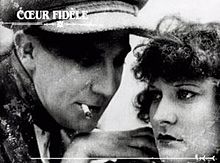- Cœur fidèle
-
Cœur fidèle 
Directed by Jean Epstein Written by Jean Epstein
Marie EpsteinStarring Gina Manès
Léon Mathot
Edmond Van Daële
Marie EpsteinCinematography Léon Donnot
Paul Guichard
Henri StuckertStudio Pathé Release date(s) 23 November 1923 Running time 87 minutes (on DVD 2007) Country France Language Silent film
French intertitlesCœur fidèle is a 1923 French drama film directed by Jean Epstein. It has the alternative English title Faithful Heart. The film tells a melodramatic story of thwarted romance, set against a background of the Marseille docks, and experiments with many techniques of camerawork and editing.
Contents
Plot
Marie (Gina Manès) was an orphan adopted by a bar-owner and his wife in the port of Marseille, and now she is harshly exploited by them as a servant in the bar. She is desired by Petit Paul (Edmond van Daële), a thuggish layabout, but is secretly in love with Jean (Léon Mathot), a dockworker. Marie is forced to leave with Petit Paul, but Jean follows them to a fairground where the two men fight. In the brawl a policeman is stabbed and, while Petit Paul escapes, Jean is arrested and gaoled. A year later, Jean rediscovers Marie, now with a sick baby and living with Petit Paul, who spends all their money on drink. Jean tries to support Marie, aided by a crippled woman (Marie Epstein, credited as "Mlle Marice"), who lives next door; but Petit Paul, warned by gossiping neighbours that Jean is seeing Marie, returns for a violent confrontation, this time armed with a gun. In the ensuing struggle, the crippled woman obtains the gun and kills Petit Paul. In an epilogue, we see Jean and Marie finally free to love each other, though their faces suggest that experience has taken its toll on their lives.
Production and style
Jean Epstein had already established himself as a film theorist with the publication of several books, and he had begun to explore his ideas in practice with his first two films, Pasteur (1922) and L'Auberge rouge (1923). Epstein now chose to film a simple story of love and violence "to win the confidence of those, still so numerous, who believe that only the lowest melodrama can interest the public", and also in the hope of creating "a melodrama so stripped of all the conventions ordinarily attached to the genre, so sober, so simple, that it might approach the nobility and excellence of tragedy".[1] He wrote the scenario in a single night.
Epstein had been much impressed by Abel Gance's recently completed La Roue, and in Cœur fidèle he sought to apply its techniques of rapid and rhythmic editing as well as the innovative use of close-ups and superimpositions of images. These techniques are most apparent during the first half of the film: the opening sequence establishing Marie's situation in the harbour bar through a series of close-ups of her face, her hands, the table and glasses that she is cleaning; the use of images of the sea and the port, either intercut or superimposed, to convey the yearnings of Jean and Marie; and the film's most celebrated sequence at the fairground in which a highly complex series of rhythmically assembled images charts the tension of the relationship between Marie and Petit Paul. The later scenes of the film are relatively conventional in the techniques employed and depend more upon situation and action than upon photography and processing of the images.
The adventurous technical experiments of the film are balanced by the realism of the setting. The characters are unglamorous and belong to a working-class milieu, living in cheap lodgings, frequenting rough bar-rooms. Cœur fidèle is one of several early films to use the location of the Marseille dockside (in the wake of Louis Delluc's Fièvre, and looking forward to Alberto Cavalcanti's En rade), and the evocative images of looming ships and deserted wharfs contribute to a style which would be characterized over the next decade and a half as "poetic realism" (cf. L'Atalante, Quai des brumes (Port of Shadows)).
Reception
The film was not a success with the public. Its initial run in Paris in 1923 was terminated after three days (because of disputes among the audience). A re-release in the following year saw a steady decline in the size of its audience.[2]. Among critics and other film-makers however Cœur fidèle attracted considerable attention and has continued to do so. Georges Sadoul said that the film "was a sensation, and was to remain [Epstein's] best film"; "it touches us still by its fidelity to everyday life".[3] René Clair wrote enthusiastically about it: " Cœur fidèle must be seen if you want to understand the resources of the cinema today. ...For a film to be worthy of the cinema, that's already a very welcome miracle! Cœur fidèle is worthy of it on more than one account."[4]
References
- ^ Jean Epstein. Présentation de "Cœur fidèle", in Écrits sur le cinéma, 1, 124 (jan. 1924) [quoted in Richard Abel, French cinema: the first wave 1915-1929 (Princeton University Press, 1984), p.360.
- ^ Richard Abel, French cinema: the first wave, 1915-1929. (Princeton University Press, 1984). p.359.
- ^ Georges Sadoul, Le cinéma français, (Flammarion, 1962): "Cœur fidèle fit sensation, et devait rester sa meilleure oeuvre." (p.29); "Et Cœur fidèle nous touche encore, par sa fidélité au quotidien." (p.30)
- ^ René Clair, Cinéma d'hier, cinéma d'aujourd'hui. (Gallimard, 1970), quoted in booklet accompanying Pathé Classique DVD (2007): "Il faut voir Cœur fidèle si l'on veut connaître les ressources du cinéma d'aujourd'hui. […] Qu'un film soit digne du cinéma, voilà déjà un bien plaisant miracle! Cœur fidèle en est digne à plus d'un titre."
External links
- Cœur fidèle at the Internet Movie Database
- Cœur fidèle at DVDtoile.com
- Cœur fidèle at AllRovi
Categories:- French films
- 1920s drama films
- 1923 films
- Black-and-white films
- Films directed by Jean Epstein
- French drama films
- French silent films
Wikimedia Foundation. 2010.
